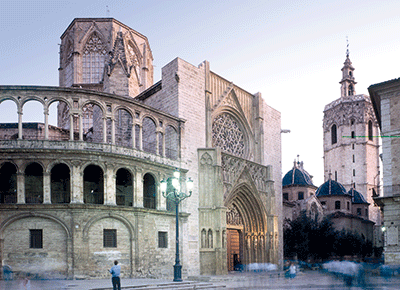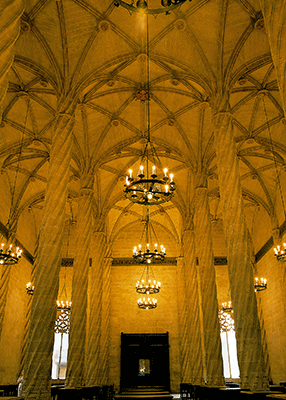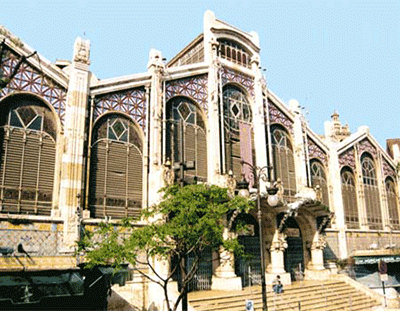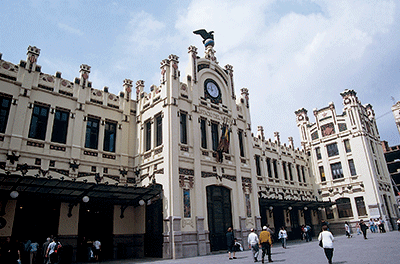Gifted with unique character, Valencia is traversed by the river Turia, overlooks the blue waters of the Mediterranean sea and shoulders a wide expanse of cypress, olive trees and coastal mountains which warmly transport you into the real essence of Spain.
Since 1996 Valencia has been a World Heritage site. Notable landmarks include the towers of the medieval city, the gothic Cathedral La Seo containing Goya‘s paintings, San Miguel monastery with its specialised library, many beautiful “plazas” and museums and the distinct futuristic Arts and Sciences complex near the port area.
The saltwat er lagoon in Albufera Natural Park, thermal spring waters and sandy beaches are all enjoyable places to relax and find tranquility, while Barrio Carmen is one of the many lively quarters where you can delight your appetite with the local tapas, a carafe of the famous Agua de Valencia and the internationally acclaimed Paella followed by pastries of middle eastern tradition.
In addition, the former bed of the Turia river is currently a large garden covering 9 km. This is a true green area, stretching from the west of the city to the east, reaching as far as the City of Arts and Sciences that can be explored by bicycle or train, and very attractive for runners.
Valencia enjoys a fame based on its good climate, great hospitality and generous shopping hours, and reflects the real pleasures of living and local life that will surely enchant you too!
PLAZA DE LA VIRGEN AND THE CATHEDRAL QUARTER
|

|
|
Built on the site of a Roman temple, which later became a mosque the origins of the cathedral date back to the 13th century. It has various architectural styles, from the Romanesque to the baroque, as can be observed on the three doors: The main door, or Puerta de los Hierros, is baroque; the Puerta de los Apóstoles is gothic and the Puerta del Palau is Romanesque. The Miguelete belfry was built in the 13th and 14th centuries and was designed by Andrés Juliá Torre; it is octagonal, 50.85m high and built in a markedly baroque style, next to the main entrance. There is a spiral stairway inside that leads to the terrace, where there are views of the city, the countryside and the sea. The Santo Cáliz Chapel, the old Sala Capitular y de Estudios (1356) was originally a Chapter House and study and was separate from the cathedral. The Holy Chalice that according to tradition was used by Christ during the last Supper is kept inside. The "Obra Nova" or "Balconets de Cabildo" were built over three floors next to the cathedral dome and they dominate the Plaza de la Virgen. It was a renaissance work of a triple serlienne arcade. |
LONJA DE LA SEDA (THE SILK EXCHANGE)
|

|
|
The Lonja is an emblematic building of the city and one of the most famous civil gothic monuments in Europe. It was declared a National Historic and Artistic Monument in July1931 and was made a World Heritage Site by UNESCO in December 1996. The Lonja is located in the centre of the city - in front of the Central Market and the Temple of Santos Juanes - and occupies a rectangular area of 1.990 square metres. At the end of the 13th century, as a result of the prosperity in Valencia at the time, the old Lonja became insufficient and it was decided to build a new Exchange. The first stone was laid in 1492, although the construction was started a year later. Pere Compte, a Valencian engineer and architect, was the principal figure involved in its construction. There are three clearly defined sections and a garden or “orange patio”. The Columnario or Sala de Contratación is divided into three longitudinal and five transversal naves with eight columns that support the domed ceiling. Its height of 17.40 meters gives the columns a special sense of size and proportion. The Taula de Canvis, set up in 1407, was located in this room by the municipal council and gained great prestige for its solvency and banking operations. The Taula or Table used for the transactions, as well as the first Bill of Exchange written in Spain are kept in the Valencia Municipal archive. The Torreón is the second section of the building while on the ground floor there is a small chapel dedicated to the Immaculate Conception. The two upper floors were used as a prison for those who reneged on their debts. |
CENTRAL MARKET
 |
|
This great modernist building was designed in 1914, although the Central Market was not inaugurated until 1928. It consists of a ground floor with columns and vaults with a brick base and a basement. Both floors are organised into straight alleys, crossed by two main lanes along which the 959 stalls are set. The ceramic covered partitions along with the stone, wood, and the colourful glasswork make the building an excellent example of the modernist architecture of the time. |
QUART AND SERRANOS TOWERS
Under the supervision of Pere Balaguer, construction began in 1392. The towers were designed to be defensive structures at one of the busiest city gates. They were saved from demolition when the city walls were knocked down in 1865 and used as a prison for the nobility between 1586 and 1887. The back of the towers have been opened so that the pointed arches and the vaulted domes can now be seen from the Plaza de los Fueros. The Towers represent an excellent example of gothic architecture.
NORTE RAILWAY STATION
|

|
|
Demetrio Ribes designed this modernist construction in 1917 in line with the ‘Secesión Vienesa’ tendency. The style is homogeneous and unique. The interior and exterior decoration is a tribute to the importance of the Valencian orange trade. The façade exhibits a gothic influence in terms of its symmetry and modulation while the quality of the mosaic work on the ceilings, walls and floors, as well as the intricate wrought-iron grilles and the myriad of colourful ceramics are superb. |
CITY OF ARTS AND SCIENCES
The City of Arts and Sciences is a cultural entertainment centre with stunning architecture and great capacity to entertain, teach and excite by promoting public participation. Situated along almost two kilometres of what was formerly the bed of the River Turia, with a surface area of 350,000 square metres, the City of Arts and Sciences is a huge open space. Offering cultural and intellectual leisure, it has given Valencia the best centre of this type in Europe. The outstanding role of its architecture was made possible thanks to the work of two Spanish architects of international renown, who have contributed the very best of their work to this area: the Valencian Santiago Calatrava, who designed the Palau de les Arts Reina Sofía, the Hemisfèric, the Príncipe Felipe Science Museum, the Umbracle, and the Ágora (under construction), and Félix Candela, designer of the unique roofing of the main Oceanográfico buildings. An architectural collection of exceptional beauty, harmonising the outer structure with the content.
For more information, visit: www.cac.es
VALENCIA´S ROYAL MARINA
|
|
|
The revamp to which the Port was treated sprang from the anticipated hosting of the 32nd and 33rd America's Cup, transforming it today into the Juan Carlos I Royal Marina. A fine example of the city's transcendence as a seaside destination and its portrayal of the quintessential Mediterranean lifestyle, the Marina characterises Valencia's ambition to establish itself as an events capital and a city for sports, through this promotion of sailing and motor racing.
|
More info at http://www.visitvalencia.com/en/home






















 Tweets por el @ECOC2015.
Tweets por el @ECOC2015.







